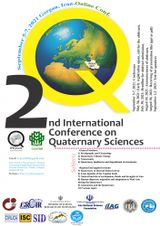Articles Stat:
Number of Articles: 65Number of Proceeding pages: 116
Papers View: 20055
2nd International Conference on Quaternary

2nd International Conference on Quaternary In date 2021-10-10 by ,Quaternary Association of Iran in City Gorgan was held. please refer to the following link to download all the papers of conference proceedings: Proceedings 2nd International Conference on Quaternary
Copyright © 2016 - All Rights Reserved - Symposia
Accepted papers in 2nd International Conference on Quaternary
Early Pleistocene climate in north Iran and its correlation with EasternAsia
Current status of Epipalaeolithic studies in South-Easter Caspian Sea
Toward the understanding of (post)pedogenic processes behind the peaks and lows of commonly used climate proxies
Active faulting, earthquakes, and geomorphology of the Main Kopeh Dagh fault, Turkmenistan
Active tectonics along the Khazar fault (Alborz, Iran)
Active tectonics of the Kalabagh Fault in Pakistan: implications from morphotectonics and luminescence dating
Age of the Khvalynian Strait in the Late Pleistocene History of the Manych Depression
Application of landform planation index (LPI) in identifying planation surfaces and paleotopography of Gorgan loess plateau (northeast of Iran)
Arctic Oscillation Modulates climate over Northeast Iran
Can Past Holocene climates and environments be used as analogs for predicting future environmental responses to global warming?
Changing the motion of Ladar fault during Quaternary, Khur area, Central Iran
Clay mineralogy of the sediments in Sabzevar playa, NE Iran; implication for the late quaternary climate changes
Climate change and its footprint on the geohazard amplification in Iran
New evidence of Late Pleistocene hominin occupations in the Southern Caspian Sea Corridor
high-resolution paleoclimate record from SE Iran reveals extreme sensitivity of West Asia to temperature changes since the Little Ice Age
Development of cryogenic processes as a factor in the loess formation in the Lower Volga valley
Environmental Changes in Lakes of Iran in Anthropocene epoch (Case study: Gavkhuni Swamp)
Evaluation of the applicability of four global grid precipitation datasets in Iran and analysis of Iran’s modern precipitation features
Forcing and feedback mechanisms of rainfall on centennial to millennial timescales
Geochemical indicators of source area and weathering intensity for the loess-paleosol sequence of Neka-Abelou, Northern Iran
Geohazard aspects of Quaternary faulting within Tehran Region, NNW of Iran
Holocene moisture variations in western arid central Asia inferred from loess records from NE Iran
How did Humans Adapt in the Eastern Farming-pastoral zone during the Medieval Warm Period?
Impact of Climate change and Caspian Sea level fall on decline of Gorgan Bay
Influence of the composition and properties of Khvalynsk deposits on the evolution of soils and soil cover in the north-western part of the Caspian Lowland (based on the results of mineralogical and micromorphological studies)
Landscape evolution in the northeastern Iranian Plateau reconstructed from Late Pleistocene to Holocene sediment archives – a project outline
Living on Quaternary Faults in Iran; High exposure problem in Earthquake Risk
Loess-paleosol sequence over ۲۳,۰۰۰ years ago in Gorgan
Lower Volga loess-paleosol sequences
Luminescence chronology of the great Khvalynian transgression from the Kosika section (Lower Volga)
Massive dust plumes over West Asia during North Atlantic cold events revealed by a dust record from southeastern Iran
Middle Pleistocene Cave of Qaleh Kurd: the oldest human occupation in IRAN
Mineralogical and geochemical characteristics of vesicular horizons of desert soils in the Rayen region-Kerman
Modern pedogenesis on loess along a climate gradient in Northern Iran
New data on the structure of the loess-soil series of Tajikistan
Palaeoenvironmental reconstructions in drylands – an example from the Binaloud Mountains in northeastern Iran
Paleoclimate and Palaeoenvironment of the Central Zagros
Paleoclimate implications from grain-size analysis of loess-paleosol sequences from the Carpathian Basin
Pedogenesis- a likely process to explain the magnetic properties of the Late Pleistocene loess-paleosol sequence at Chenarli, northeastern Iran
Pedogenetic response to climatic fluctuations within the last glacialinterglacial cycle in the Lower Volga basin
Pedostratigraphy of the Kuban loess-paleosol sequences
Persian Gulf Holocene sedimentary environment based on two cores in shallow part of Bandar Abbas and Bushehr
Quantitative estimates of Holocene glacier meltwater variations on the Western Tibetan Plateau
Quaternary geology, active tectonics and urban development of the Tehran city
The dating evidence for the earliest domesticated cattle and sheep/goats and pastoralism history in Gansu-Qinghai regions, NW China
Rock Magnetic Records of Baluchabad Loess-Paleosol Sequences, Northern Iran
Soil erosion and its trend in Iran by comparing several case studies
Soil Erosion Susceptibility Mapping Using GIS and AHP Case Study Kalat-e-Naderi, Northeast Iran
Southeast Caspian coast evolution during Holocene
Speleothems: a Quaternary archive of hydroclimate change in Iran
Stages of loess accumulation of the multilayer Kulbulak Palaeolithic site (Uzbekistan)
Stratigraphy and Moisture Changes revealed from Iranian Loess- Paleosol in the Western Arid Central Asia since the Last Interglacial
Structure and chronology of the Chocolate clays facies of the Lower Volga
Subsurface erosion by soil piping – significance and consequences
Taman loess-paleosol sequence: structure, age, genesis
The analysis of Meteorological Parameters Influencing dust Genesis over the Middle East
The diffusion of animal husbandry in Eurasia and its influence on Hexi Corridor, NW China
The effect of flood on soil degradation in Gorganrud River Basin
The Effects of the Southern Zagros Folded Zone on the Adaptive Strategies of the Late Pleistocene Human Occupations in Fars Province
The Holocene events in the Caspian Sea
Climate variability analysis for evolution effect over the Garmsar Alluvial fan, Based on field measurements
The Late Quaternary Environmental changes in Iran
The Paleolithic cave of Qaleh Kord (Qazvin, IRAN): geoarchaeological study by using micromorphology and physical-chemical analysis
The role of the aeolian factor in the formation of the landforms of the Lower Volga region
The spatial and possess analyses of piping and gully head erosions using unmanned aerial vehicles (UAV) images